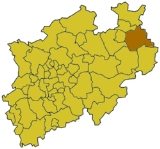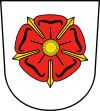
Lippe
Encyclopedia
Lippe (ˈlɪpə) is a Kreis (district
) in the east of North Rhine-Westphalia
, Germany
. Neighboring districts are Herford
, Minden-Lübbecke
, Höxter
, Paderborn
, Gütersloh
, and district-free Bielefeld
, which forms the region Ostwestfalen-Lippe
.
The district of Lippe is named after the Lords of Lippe and their Principality of Lippe
. It was a state within the Holy Roman Empire
and today is a district of North Rhine-Westphalia.
Unlike many other countries of the Holy Roman Empire
in the area, Lippe kept its independence in the Napoleonic era, and thus wasn't incorporated into Prussia
afterwards. It was one of the smaller member states of the German empire.
After the death of Prince Woldemar
in 1895, the two lines of the House of Lippe
fought over the regency for over a decade.
The last prince of Lippe was forced to abdicate in 1918 after the end of World War I
when Germany became a republic; his country became a Freistaat in the German republic. In 1932 the state was subdivided into two districts, Detmold and Lemgo. These continued to exist when in 1947 Lippe lost its status as a state of Germany and by order of the British military government was incorporated into the new federal state North Rhine-Westphalia
; in 1949 this change was approved by the parliament. In 1969/70 the 168 cities and municipalities were merged to 16; and as the second part of the administrative reform in 1973 the two districts Lemgo and Detmold were merged to the district Lippe.
, which also contain the highest elevation of the district, the 496 meter high Köterberg near Lügde
. The lowest elevation is at the Weser river with 45.5 m. The main river is the Werre
, and at the northern border of the district the Weser.
. In the past it was known as a meal for poor people. The main ingredients are potatoes, flour and raisins.
Districts of Germany
The districts of Germany are known as , except in the states of North Rhine-Westphalia and Schleswig-Holstein where they are known simply as ....
) in the east of North Rhine-Westphalia
North Rhine-Westphalia
North Rhine-Westphalia is the most populous state of Germany, with four of the country's ten largest cities. The state was formed in 1946 as a merger of the northern Rhineland and Westphalia, both formerly part of Prussia. Its capital is Düsseldorf. The state is currently run by a coalition of the...
, Germany
Germany
Germany , officially the Federal Republic of Germany , is a federal parliamentary republic in Europe. The country consists of 16 states while the capital and largest city is Berlin. Germany covers an area of 357,021 km2 and has a largely temperate seasonal climate...
. Neighboring districts are Herford
Herford (district)
Herford is a Kreis in the northeastern part of North Rhine-Westphalia, Germany. Neighboring districts are Minden-Lübbecke, Lippe, the urban district of Bielefeld, and the districts Gütersloh and Osnabrück.-History:...
, Minden-Lübbecke
Minden-Lübbecke
Minden-Lübbecke is a Kreis in the northeastern part of North Rhine-Westphalia, Germany. Neighboring districts are Diepholz, Nienburg, Schaumburg, Lippe, Herford, Osnabrück.-Geography:...
, Höxter
Höxter (district)
Höxter is a Kreis in the east of North Rhine-Westphalia, Germany. Neighboring districts are Holzminden, Northeim, Kassel, Waldeck-Frankenberg, Hochsauerland, Paderborn, and Lippe.-History:...
, Paderborn
Paderborn (district)
Paderborn is a Kreis in the east of North Rhine-Westphalia, Germany. Neighboring districts are Gütersloh, Lippe, Höxter, Hochsauerland, and Soest.-History:...
, Gütersloh
Gütersloh (district)
Gütersloh is a Kreis in the north-east of North Rhine-Westphalia, Germany. Neighboring districts are Osnabrück, Herford, district-free Bielefeld, Lippe, Paderborn, Soest and Warendorf.-History:...
, and district-free Bielefeld
Bielefeld
Bielefeld is an independent city in the Ostwestfalen-Lippe Region in the north-east of North Rhine-Westphalia, Germany. With a population of 323,000, it is also the most populous city in the Regierungsbezirk Detmold...
, which forms the region Ostwestfalen-Lippe
Ostwestfalen-Lippe
Ostwestfalen-Lippe , abbreviation OWL, is a region in the German state of North Rhine-Westphalia, with a 2,000-years-old history and culture. Ostwestfalen-Lippe is the eastern part of the region of Westphalia, joined with the Lippe region. Translated to English, the name would be East...
.
The district of Lippe is named after the Lords of Lippe and their Principality of Lippe
Principality of Lippe
Lippe was a historical state in Germany. It was located between the Weser River and the southeast part of the Teutoburg forest.-History:...
. It was a state within the Holy Roman Empire
Holy Roman Empire
The Holy Roman Empire was a realm that existed from 962 to 1806 in Central Europe.It was ruled by the Holy Roman Emperor. Its character changed during the Middle Ages and the Early Modern period, when the power of the emperor gradually weakened in favour of the princes...
and today is a district of North Rhine-Westphalia.
History
The Lippe district nearly covers the same area as the historic country Lippe. The first mention of this country was in 1123; it grew in power slowly in the following centuries. In 1528 it became a county, in 1789 it was elevated to a principality.Unlike many other countries of the Holy Roman Empire
Holy Roman Empire
The Holy Roman Empire was a realm that existed from 962 to 1806 in Central Europe.It was ruled by the Holy Roman Emperor. Its character changed during the Middle Ages and the Early Modern period, when the power of the emperor gradually weakened in favour of the princes...
in the area, Lippe kept its independence in the Napoleonic era, and thus wasn't incorporated into Prussia
Prussia
Prussia was a German kingdom and historic state originating out of the Duchy of Prussia and the Margraviate of Brandenburg. For centuries, the House of Hohenzollern ruled Prussia, successfully expanding its size by way of an unusually well-organized and effective army. Prussia shaped the history...
afterwards. It was one of the smaller member states of the German empire.
After the death of Prince Woldemar
Woldemar, Prince of Lippe
Woldemar of Lippe was the sovereign of the Principality of Lippe reigning from 1875 until his death.-Early life and reign:...
in 1895, the two lines of the House of Lippe
House of Lippe
The House of Lippe is a German Royal House. The House of Lippe descends from Count Jobst Hermann of Lippe whose son Bernhard I was the founder of the state of Lippe in 1123....
fought over the regency for over a decade.
The last prince of Lippe was forced to abdicate in 1918 after the end of World War I
World War I
World War I , which was predominantly called the World War or the Great War from its occurrence until 1939, and the First World War or World War I thereafter, was a major war centred in Europe that began on 28 July 1914 and lasted until 11 November 1918...
when Germany became a republic; his country became a Freistaat in the German republic. In 1932 the state was subdivided into two districts, Detmold and Lemgo. These continued to exist when in 1947 Lippe lost its status as a state of Germany and by order of the British military government was incorporated into the new federal state North Rhine-Westphalia
North Rhine-Westphalia
North Rhine-Westphalia is the most populous state of Germany, with four of the country's ten largest cities. The state was formed in 1946 as a merger of the northern Rhineland and Westphalia, both formerly part of Prussia. Its capital is Düsseldorf. The state is currently run by a coalition of the...
; in 1949 this change was approved by the parliament. In 1969/70 the 168 cities and municipalities were merged to 16; and as the second part of the administrative reform in 1973 the two districts Lemgo and Detmold were merged to the district Lippe.
Geography
The Lippe district covers the northern part of the Teutoburg ForestTeutoburg Forest
The Teutoburg Forest is a range of low, forested mountains in the German states of Lower Saxony and North Rhine-Westphalia which used to be believed to be the scene of a decisive battle in AD 9...
, which also contain the highest elevation of the district, the 496 meter high Köterberg near Lügde
Lügde
Lügde is a town in the Lippe district of North Rhine-Westphalia, Germany, with c. 11,000 inhabitants.The first written issue of Lügde appears in 784, in the annals of the Frankish Empire, when Charlemagne visited the village during the Saxon Wars....
. The lowest elevation is at the Weser river with 45.5 m. The main river is the Werre
Werre
The Werre is a river in the Detmold region of North Rhine-Westphalia, Germany, left tributary of the Weser. Its source is near Horn-Bad Meinberg. The Werre flows generally north through the towns Detmold, Lage, Bad Salzuflen, Herford and Löhne. It flows into the Weser close to Bad Oeynhausen. The...
, and at the northern border of the district the Weser.
Coat of arms
 |
The coat of arms shows the traditional symbol of the state of Lippe, the rose, as the district covers nearly the same area as the historic country. In the middle of the rose 16 stamen Stamen The stamen is the pollen producing reproductive organ of a flower... s symbolize the 16 cities and municipalities of the district. The coat of arms was granted in 1973. Despite the relatively small size of Lippe, the Lippish rose is also one of only three symbols included in the coat of arms of the state of North Rhine-Westphalia. |
Towns and municipalities
| Towns | Municipalities |
|---|---|
|
Augustdorf Augustdorf is a municipality in the Lippe district of North Rhine-Westphalia, Germany. It has an area of 42.21 km² and c. 10,000 inhabitants.-External links:*... Dörentrup Dörentrup is a municipality in the Lippe district of North Rhine-Westphalia, Germany. It has an area of 49.79 km² and c. 8,600 inhabitants .- Respect of the nocturnal environment :... Extertal Extertal is a municipality in the Lippe district of North Rhine-Westphalia, Germany, with c. 12,600 inhabitants.Extertal is located on the northern edge of the circle in the Teutoburg Nature Reserve, directly adjacent to Lower Saxony. The Exter and Humme rivers flow through the region. The... Kalletal Kalletal is a municipality in the Lippe district of North Rhine-Westphalia, Germany, with c. 15,300 inhabitants.-Comprising villages :* Asendorf* Bavenhausen* Bentorf* Brosen* Erder* Heidelbeck* Henstorf* Hohenhausen* Kalldorf... Leopoldshöhe Leopoldshöhe is a municipality in the Lippe district of North Rhine-Westphalia, Germany, with c. 16,000 inhabitants.Located in the rolling plains north of the Teutoburger Wald range, Leopoldshöhe consists of eight formerly independent municipalities: Asemissen, Bechterdissen and Greste to the... Schlangen Schlangen is a municipality in the Lippe district of North Rhine-Westphalia, Germany. Schlangen has c. 9,000 inhabitants and exists in relative prosperity... |
Culinary art
The most famous dish served in Lippe is the PickertPickert
A Pickert is a flat, fried or baked potato dish from Westphalia, Germany. It can be considered a kind of flattened dumpling or very nourishing pancake. It comes as a round Pfannenpickert the size of a pan, a rectangular Kastenpickert or palm-sized regular Pickert...
. In the past it was known as a meal for poor people. The main ingredients are potatoes, flour and raisins.
External links
- Official website
- Ordinances and by-laws of the county of Lippe online
- Guidelines for the integration of the Land Lippe within the territory of the federal state North-Rhine-Westphalia of 17 January 1947 - Religious history of Lippe from the Reformation until the early twentieth century

